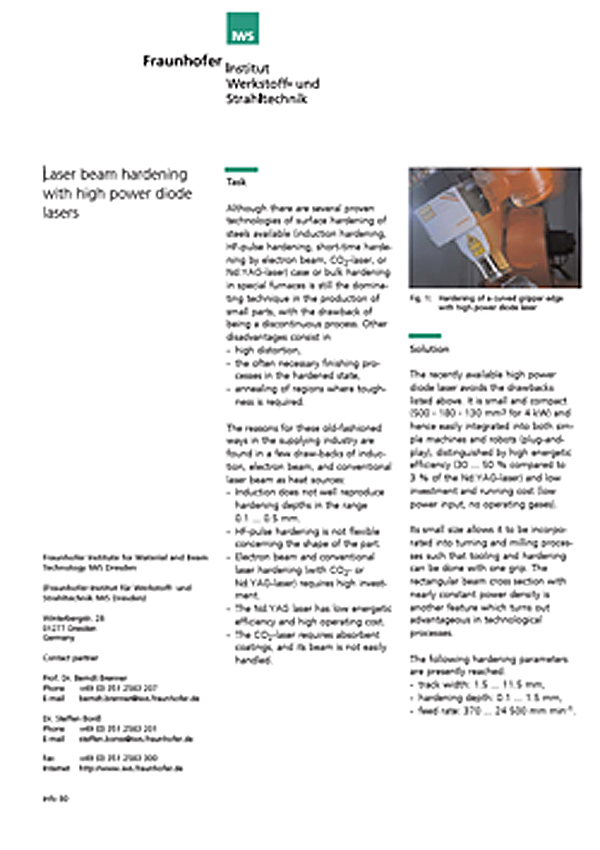

Although there are several proven technologies available for the surface hardening of steels (induction hardening HF-pulse hardening short-time hardening by electron beam CO2-laser or Nd:YAG-laser) case or bulk hardening in special furnaces is still the dominating technique in the production of small parts with the drawback of being a discontinuous process. Other disadvantages include high distortion the frequent need for a finishing processes in the hardened state; and the need to anneal regions where toughness is required. The reasons for these old-fashioned ways in the supplying industry are found in a few draw-backs of induction electron beam and conventional laser beam as heat sources: induction does not well reproduce hardening depths in the range 0.1 ... 0.5 mm; HF-pulse hardening is not flexible with regard to the shape of the part; electron beam and conventional laser hardening (with CO2- or Nd:YAG-laser) requires high investment. The Nd:YAG laser has a low electrical efficiency and high operating cost whereas the CO2 laser requires absorbent coatings and its beam is not easily handled. High power diode lasers avoid these drawbacks. The laser is small and compact (500 x 180 x 130 mm3 for 4 kW) and hence easily integrated into both simple machines and robots (plug-and-play) distinguished by high energetic efficiency (30 .-. 50 % compared to 3 % of the Nd:YAG-laser) and low investment and running cost (low power input no operating gases). Its small size allows it to be incorporated into turning and milling processes such that tooling and hardening can be done with one grip. The rectangular beam cross section with nearly uniform power density is another feature that is advantageous for this processes. The following hardening parameters are presently reached: -track width: 1.5 - 11.5 mm hardening depth: 0.1 - 1.5 mm feed rate: 370 -. 24 500 mm min-1. The unique and up to now unmatched properties of this novel beam tool in the power range up to 2 kW justify the assumption that it will find many industrially applications for hardening depths of 0.1 - 1 mm such as for thin-walled and warp-prone parts inner surfaces parts with functional faces. Such applications include mechanical precision parts subjected to wear (as in printing hydraulics control shafts miniature support rails) small tools (as punches crimping bending and folding tools) small textile machine parts (as needles and ears) small motor parts (as piston rings injector needles injector seats) medical instruments especially for minimal invasive surgery (as pincers knives scissors needles). This technique is suitable for annealing steels spring steels martensite hardening cold heading cold extrusion and valve steels tool steels cold work tool steels. The document contaqins an example of the laser beam hardening of a GGG70 cam disk for printing machines is used to demonstrate the possibility of high power diode lasers for hardening. According to the function of the cam disk only the edges of the curve were to be hardened. The distortion of the disk due to heat input was minimal. The surface temperature was kept constant during the process with an accuracy of +/- 5 K by a feedback system involving rapid pyrometry and beam power control. Parameters include a beam power of 800 - 1000 W a spot size 8 x 8 mm2 and a feed rate 125 m min-1
View Document (125Kb)
Copyright of ©2006 Fraunhofer Institute IWS Dresden
We make every effort to trace copyright. If inadvertently we have not attributed copyright or attributed it incorrectly, please contact us using our webform or by emailing dlm@ailu.org.uk and we will rectify the situation.
Disclaimer
To view disclaimer details click here